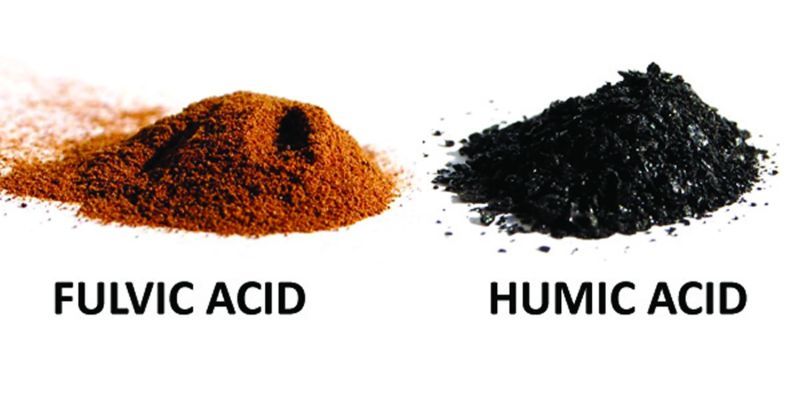Humic and Fulvic Acids in Organic Farming: The Secret Weapons for Soil Health and Higher Yields
Organic farming emphasizes sustainable practices that work in harmony with nature to produce healthy crops, restore soil fertility, and protect the environment for future generations. Among the most powerful natural tools revolutionizing organic agriculture are humic acid and fulvic acid.
These organic compounds, derived from decomposed matter like leonardite, peat, or compost, are integral components of humus — the stable and nutrient-rich fraction of soil organic matter. Their unique molecular structures, biological functions, and environmental benefits make them essential for improving soil structure, nutrient availability, and plant vitality.
In this comprehensive guide, we’ll explore the science behind humic and fulvic acids, their specific roles in organic farming systems, and how they contribute to sustainable crop production and ecosystem restoration.

🌱 What Are Humic and Fulvic Acids?
Humic and fulvic acids are types of humic substances, the natural by-products of organic decomposition. These acids differ in molecular structure, function, and soil interaction — yet both are critical to enhancing soil biology and boosting plant performance.
1. Humic Acid
Definition: A complex group of large organic molecules formed during the microbial decomposition of plant and animal matter.
Origin: Extracted from soils, peat, coal (especially leonardite), and natural water bodies.
Molecular Weight: High
Color: Dark brown to black
Solubility: Insoluble in water at low pH but becomes soluble in alkaline conditions (higher pH)
2. Fulvic Acid
Definition: A smaller, more chemically reactive fraction of humic substances with lower molecular weight and higher biological activity.
Molecular Weight: Low
Color: Yellow to amber
Solubility: Fully water-soluble across all pH levels, making it ideal for foliar feeding and plant cell penetration
💡 Did You Know? Fulvic acid molecules are small enough to enter plant cells and transport nutrients directly into plant tissues — a rare feature among organic compounds.
🌿 How Are They Formed?
Humic and fulvic acids originate from a natural process called humification — the biochemical breakdown of organic matter (plant residues, animal waste) under microbial activity, low oxygen, and the influence of moisture and temperature over centuries.
In agricultural contexts, the most potent sources of humic and fulvic acids come from:
Leonardite: A highly oxidized form of lignite (brown coal) rich in humic substances.
Peat and Compost: Organic residues further decomposed into humus.
Vermicompost: Earthworm-digested compost containing fulvic-rich extract.
These substances are extracted for commercial use in liquid, granular, and powder forms, widely applied in organic and regenerative farming systems.
🌾 Why Are Humic and Fulvic Acids Important in Organic Farming?
These compounds act as natural biostimulants, soil conditioners, and nutrient enhancers, driving fundamental improvements in soil ecology and crop productivity.
🔑 Key Benefits of Humic and Fulvic Acids
1. Soil Structure Improvement
a. Enhanced Soil Aggregation
Humic acid improves aggregation in both sandy and clay soils by binding particles into stable clumps.
This leads to better aeration, reduced erosion, and improved root penetration.
b. Water Retention
Humic substances improve soil porosity and water-holding capacity by up to 30%.
Crucial for dry climates or drought-prone regions.
📈 Real Impact: Farmers in arid zones report better water efficiency and healthier crops with humic acid applications.
![Humi[K] WSP Humi[K] WSP](https://cdn.durable.co/blocks/31DHpFINRD8uq3yK2VSZ9vDAgYC1VLmbwgv4BTAxQbbS970cLE6CCCzejD7HA7Gu.jpg) Learn more About Humi[K] WSP in Nigeria
Learn more About Humi[K] WSP in Nigeria
2. Nutrient Chelation and Bioavailability
a. Chelation of Micronutrients
Humic and fulvic acids act as natural chelating agents, binding micronutrients like iron, zinc, manganese, and copper.
This makes them readily available to plant roots and prevents leaching.
b. Improved Cation Exchange Capacity (CEC)
Humic acids boost the CEC of soils, increasing nutrient retention and reducing fertilizer losses.
💰 Economic Benefit: This reduces the need for synthetic fertilizers, saving money and preserving soil fertility.
3. Stimulates Soil Microbiology
Humic and fulvic acids are carbon-rich food for beneficial microbes.
They:
a. Activate microbial communities
b. Enhance nitrogen fixation
c. Suppress soil-borne diseases
d. Accelerate organic matter decomposition
🧬 Fun Fact: A vibrant microbial ecosystem is key to transforming raw nutrients into plant-available forms.
4. Promotes Root Development and Plant Growth
Acts as a natural growth promoter, leading to:
- Longer, more fibrous roots
Faster germination
Stronger seedling establishment
Fulvic acid enters plant cells directly to stimulate metabolic activity and chlorophyll synthesis.
5. Detoxifies Contaminated Soils
Binds heavy metals like cadmium, arsenic, and lead, reducing their toxicity.Breaks down pesticide residues and hydrocarbon pollutants.Supports soil restoration in degraded or previously chemically treated land.
🌻 Benefits in Crop Production
Key Benefits of Humic and Fulvic Acids in Crop Production:Higher Yields: Increases crop output by 10 to 30 percent, especially in cereals, vegetables, and legumes
1. Soil Application
Better Nutrient Uptake: Maximizes plant access to macro and micronutrients
Stress Resistance: Improves resilience against drought, salinity, and temperature swings
Improved Germination: Enhances seed vigor, uniform sprouting, and early plant development
Reduced Fertilizer Costs: Cuts down synthetic fertilizer usage due to improved nutrient efficiency
🚜 Application Methods in Organic Farming
Best used before planting or during crop growth via drip irrigation, furrow drenching, or soil dribbling.
Dosage: Granular: 1–5 kg/ha Liquid: 1–3 L/ha
2. Seed Treatment
Soak seeds in diluted fulvic acid solution for 12–24 hours.
Enhances germination and root vigor.
3. Foliar Spray
Apply fulvic acid as a foliar mist for fast nutrient delivery.
Use during critical growth stages: flowering, fruiting, or nutrient stress.
4. Compost Enhancement
Add humic acid to compost piles to speed up decomposition and stabilize nutrients.
Creates high-quality compost tea or vermicast extract.
📚 Scientific Evidence Supporting Their Use
🔬 Research Highlights
✅Frontiers in Plant Science (2017): Fulvic acid increased chlorophyll content and photosynthetic rate in wheat.
✅Journal of Plant Nutrition and Soil Science: Humic acid enhanced phosphorus availability in calcareous soils.
✅Agronomy Journal Meta-Analysis: Found 20% average increase in root biomass across crops.
✅Indian Agricultural Trials: Combined use with organic fertilizers led to up to 25% yield boost in rice and maize.
✅ Organic Certification & Compliance
While humic and fulvic acids are naturally derived, organic farmers must ensure:
Certifier Approval: Check inputs against USDA NOP, EU Organic, or IFOAM standards.
Sourcing Integrity: Ensure they’re extracted using permitted methods (no synthetic solvents).
Label Review: Always review ingredients and declarations for compatibility with organic regulations.
🧠 Tips for Farmers and Growers
Test first: Always conduct small-scale trials on your soil type and crops.
Monitor: Regularly check soil pH, EC levels, and microbial activity.
Combine practices: Use alongside cover crops, mulching, manure, and crop rotation.
Don’t overdose: Higher application doesn’t always mean better results. Stick to recommended rates.
🌍 Conclusion: A Natural Boost for Soil and Sustainability
In the quest for sustainable, eco-friendly agriculture, humic and fulvic acids stand out as game-changing allies. From revitalizing soils and boosting yields to reducing fertilizer dependence, they offer a practical, affordable, and regenerative solution.
Whether you're managing a backyard organic garden or scaling up a regenerative farming operation, integrating these powerful biostimulants can help you grow healthier crops, restore soil health, and contribute to food security and environmental restoration.
📌 References
✅Nardi, S., et al. (2017). "Physiological effects of humic substances on higher plants." Soil Biology and Biochemistry, 34(11), 1527–1536.
✅Canellas, L.P., et al. (2015). "Humic and fulvic acids as biostimulants in agriculture." Scientia Agricola, 72(4), 311–319.
✅Rose, M.T., et al. (2014). Agronomy Journal, 106(3), 817–827.
✅Zhang, W., & Ervin, E.H. (2008). "Humic substances influence drought responses in Kentucky bluegrass." Crop Science, 48(1), 339–346.
✅USDA National Organic Program – www.ams.usda.gov
✅European Commission Organic Regulations – eur-lex.europa.eu
#OrganicFarming #SoilHealth #HumicAcid #FulvicAcid #SustainableAgriculture #RegenerativeFarming #Biostimulants #EcoFarming #SoilMicrobiology #FarmingTips #CompostTea #Agroecology
